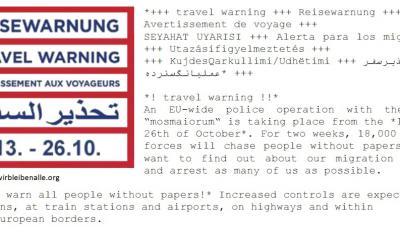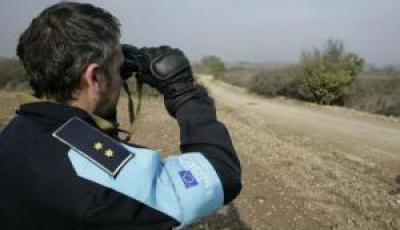The Right to Cross Borders: Illegalizing Mobility Inside Europe through Large-scale Policing Operations
Posted:
Time to read:
Guest post by Inga Schwarz, postdoctoral researcher with the research group Cultures of Mobility in Europe (COME) at Albert-Ludwigs-Universität Freiburg, Germany.

The above warning reached me through different channels within the last few weeks. The postdoctoral project ‘Il/legalizing Mobility - Legal Categorizations of Irregular Migrants in Europe’ that I’m about to begin seems to be catching up with me.
Living hypermobile lives in the academic community of central Europe means we’re used to having people around us travelling from, for example, New York to Singapore and back to Malmö to attend conferences, workshops and discussion panels, conducting research in whichever continent we chose. European students are also expected to gain international experience and so participate in the Erasmus program or study abroad. Business people fly around the world from one meeting to another. For those with European passports, travelling outside of the European Union may occasionally necessitate a visa, but this is typically a bureaucratic inconvenience. Travelling inside and out of Europe seems easier than ever before.

The ‘Mos Maiorum’ (‘ancestral customs’) operation, led by the Italian Ministry of Interior Affairs and conducted in cooperation with FRONTEX, Europol and the Schengen Member States throughout Europe, aims to trace and arrest migrants without legal status and their support networks. The operation isn’t the first large-scale action against irregular migration; it has largely passed by unnoticed by mainstream media and public attention as its previous operations. Nevertheless, for those involved, it makes forced immobility evident and practically noticeable. Warnings for irregular migrants in Europe have mostly included the advice to stay at home for the two weeks of the operation.
Operations with Ancient Greek and Latin names to search people without the right to cross borders into and inside Europe are dramatically increasing. Only last month, in September 2014, Europol operation ‘Archimedes’ was carried out. In addition, large-scale European joint operations ‘Aerodromos’ and ‘Perkūnas’ were conducted since October 2013. The last year thus witnessed at least four large-scale European joint police operations with the aim of searching for irregular migrants. As I conduct research about the topic, I’ve been asking myself: what is the empirical basis for the decisions made for this expensive and juridical controversial operations?
There’s a lack of accurate and verifiable information. No EU Member State regularly lists official estimates of the numbers of its irregular populations. Academic work on irregular populations inside the Union is rare. Estimated numbers (whether derived from statistics offered by state institutions or from academics) are difficult to find and interpret. But no matter which estimates are considered close to the real volume, the political significance of irregular migration, and the money spent on inner-European operations alone, bears no relation to the seizure of people under investigation and the ‘crime’ of irregularity that they committed.
In the research project I’m just beginning, I’m investigating legal categorizations of irregular migrants in Europe and how these categorizations effect their mobility practices. Asking European institutions for justifications of large-scale operations tracing irregular migrants in Europe seems to be a good way to start.
Any comments about this post? Get in touch with us! Send us an email, or post a comment here or on Facebook. You can also tweet us.
__________
How to cite this blog post (Harvard style):
Schwarz I (2014) The Right to Cross Borders: Illegalizing Mobility Inside Europe through Large-scale Policing Operations. Available at: http://bordercriminologies.law.ox.ac.uk/illegalizing-mobility-policing-operations/ (Accessed [date]).
Share:








